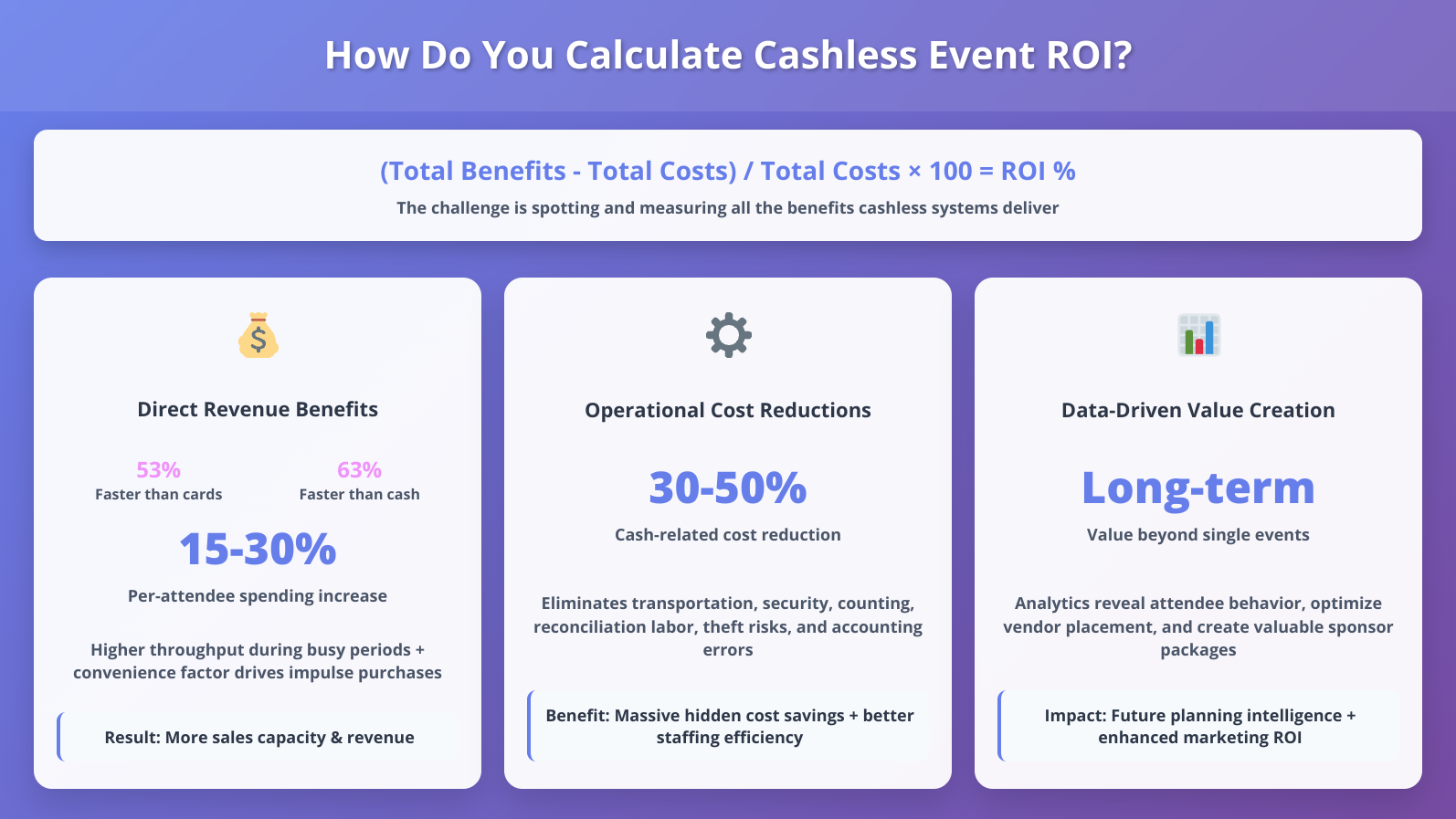The ROI of Cashless Event Technology: What Organizers Need to Know

Cashless event technology generates measurable returns that transform event profitability and operational efficiency.
- Revenue increases of 15-40% through faster transactions and increased spending per attendee
- Operational cost reductions of 30-50% via eliminated cash handling and streamlined processes
- Enhanced data collection enables real-time optimization and future event improvements
- Implementation typically pays for itself within 1-3 events through combined savings and revenue gains
Smart event organizers are making cashless technology investments the cornerstone of their growth strategy.
Why Cashless Event ROI Matters More Than Ever
Event organizers are feeling the heat like never before. Every dollar spent needs to pull its weight and show real results. With global event industry spending hitting new peaks and 74% of event marketers expecting budget increases in 2025, the question isn't whether to invest in technology, but it's how to choose cashless payment solutions that generate the strongest returns.
Cashless event ROI has become the ultimate game-changer, separating events that barely scrape by from those that turn into serious money-makers. Unlike old-school payment methods that create headaches and hidden costs, smart cashless systems flip every transaction into a chance for bigger revenue and smoother operations.
The numbers don't lie. According to Allied Market Research, the events industry is shooting for $2.5 trillion by 2035, powered largely by tech innovations that make attendees happy while boosting organizer profits. Event organizers who jump on data-driven cashless solutions early are positioning themselves to grab a bigger slice of this massive, growing pie.
How Do You Calculate Cashless Event ROI?
Getting a handle on cashless event ROI means looking way beyond simple cost comparisons. You need to dig into the total economic impact on your entire event operation. The calculation covers both direct money-making wins and operational improvements that save you cash down the road.
The basic ROI formula for cashless event technology starts simple: (Total Benefits - Total Costs) / Total Costs × 100 = ROI Percentage. But here's where it gets interesting—the real challenge is spotting and measuring all the benefits that cashless systems actually deliver.
Direct Revenue Benefits
Direct revenue bumps are the most obvious part of cashless event ROI. Faster transaction processing means higher throughput when things get crazy busy, cutting down on revenue lost to endless lines and frustrated attendees who just give up and walk away. Studies show cashless transactions zip through 53% faster than credit cards and 63% faster than cash—that directly translates to more sales capacity.
Per-attendee spending typically jumps 15-30% when cashless systems remove the friction from buying stuff. The convenience factor encourages impulse purchases, while built-in loyalty programs and promotional features drive extra revenue through targeted offers and smart upselling.
Operational Cost Reductions
Cash handling is like this massive hidden cost monster that cashless systems just eliminate completely. We're talking transportation, security, counting time, reconciliation labor, plus the constant worry about theft or accounting mess-ups. Most events slash their cash-related operational costs by 30-50% when they go full cashless.
Staffing efficiency improvements are another huge win for ROI calculations. Real-time data analytics let you move staff around based on what's actually happening, cutting overstaffing when things are slow while making sure you've got enough people when it gets wild.
Data-Driven Value Creation
The analytics power of modern cashless systems creates value that goes way beyond just individual events. Detailed transaction data reveals how attendees actually behave, when things get busy, and what they really want to buy. This intel shapes future planning and makes sponsor packages way more valuable.
This data lets organizers optimize vendor placement, tweak pricing strategies, and create laser-targeted marketing campaigns for future events. The long-term value of these insights often beats the immediate financial returns from faster processing and increased sales.

What Are the 7 Ways Cashless Technology Delivers Measurable ROI?
Event organizers who dive into cashless technology keep reporting wins across tons of different areas. These seven key benefit categories give you the roadmap for understanding and measuring your investment returns.
1. Accelerated Transaction Processing and Revenue Capture
RFID payment systems blast through transactions in seconds instead of minutes, letting vendors serve way more customers when things get intense. This boosted throughput directly translates to higher revenue per hour, which is absolutely crucial during limited-time events or those crazy rush periods.
The speed advantage becomes exponential when you're slammed. A vendor who used to serve 100 customers per hour can suddenly handle 150-200 with cashless tech—that's a 50-100% bump in revenue capacity during your most profitable moments.
2. Elimination of Cash Handling Costs and Security Risks
Traditional cash operations are a pain—you need secure transportation, counting people, reconciliation time, and insurance against theft. These costs usually eat up 2-4% of your total cash revenue, which adds up fast for big events with serious cash flow.
Cashless systems wipe out these expenses completely while cutting the risk of internal theft and accounting nightmares. The security benefits go beyond just saving money—you get reduced liability and better staff accountability through digital transaction trails that tell the whole story.
3. Enhanced Attendee Spending Through Convenience
Friction-free payments get people spending more by removing all those annoying barriers to buying decisions. When attendees don't need to figure out exact change or stress about running out of cash, they make way more spontaneous purchases and go for the pricier stuff.
Payment wristband technology is especially good at driving spending increases by making transactions totally effortless. Attendees load up funds ahead of time and then spend without really thinking about individual transaction amounts—hello, higher overall spending.
4. Real-Time Analytics for Operational Optimization
Live transaction data lets you make immediate adjustments to staffing, inventory, and operations. Event organizers can spot bottlenecks as they happen and shuffle resources around to keep service levels awesome throughout the entire event.
This real-time visibility stops revenue loss from stockouts, too many staff, or vendors in terrible spots. Being able to make data-driven adjustments during the event seriously improves profitability compared to the old "analyze everything after it's over" approach.
5. Streamlined Vendor Management and Revenue Sharing
Digital payment systems make vendor onboarding, sales tracking, and revenue distribution a breeze. Automated reporting kills manual reconciliation processes while giving transparent, real-time visibility into each vendor's performance and commission math.
This operational efficiency cuts administrative overhead while enabling more sophisticated vendor management strategies like performance-based placement fees or dynamic commission structures that reward vendors for crushing their sales goals.
6. Reduced Labor Requirements and Training Costs
Cashless systems need minimal staff training and eliminate tons of manual processes that come with cash handling. New employees can get productive quickly, while experienced staff can focus on customer service instead of transaction processing and money management headaches.
The simplified operations cut labor costs during events while making service quality way better. Staff members spend more time actually engaging with attendees and less time counting money or fixing payment problems.
7. Data-Driven Revenue Optimization for Future Events
Transaction analytics give you insights that make planning for future events so much smarter. Understanding when things get crazy busy, what products people actually want, and how attendees flow through your space enables better vendor placement, pricing strategies, and capacity planning that maximizes revenue potential.
This historical data becomes more valuable over time, creating a serious competitive advantage for organizers who can predict and optimize for how attendees actually behave. The cumulative value of these insights often beats the immediate ROI from operational improvements.
What's the True Implementation Cost vs. Return Analysis?
Getting a grip on the complete cost structure of cashless event technology helps organizers make smart investment decisions and set realistic ROI expectations. The analysis needs to account for both upfront implementation costs and ongoing operational savings.
Initial Investment Components
Hardware costs are the most obvious expense: payment terminals, RFID readers, and networking equipment. But here's the thing: modern cashless solutions often work on service models that spread these costs across multiple events instead of hitting you with massive upfront bills.
Software licensing, integration services, and staff training make up the rest of implementation costs. These expenses vary a lot based on how complex your event is and what tech infrastructure you already have, but they typically represent 20-30% of your total implementation budget.
Break-Even Timeline Analysis
Most event organizers hit break-even on cashless technology investments within 1-3 events, depending on event size and how often you run them. Big festivals with tons of transactions often recover implementation costs during their very first event, while smaller events might need 2-3 rounds to achieve full ROI.
The break-even calculation has to include both direct revenue increases and operational cost savings. Events with major cash handling expenses or labor-intensive payment processes typically see faster returns than those with simpler operational setups.
Long-Term Value Accumulation
The ongoing benefits of cashless systems compound over time as organizers optimize operations based on accumulated data and experience. Second and third events using the same technology platform typically show 25-50% better performance metrics than initial implementations.
Multi-event ROI analysis reveals the true value proposition of cashless technology investments. While initial returns may be modest, the cumulative benefits over multiple events create substantial value that far exceeds simple transaction processing improvements.
How Do Leading Events Achieve Maximum RFID Revenue Boost?
Successful event organizers maximize their RFID revenue boost through smart implementation approaches that go way beyond basic payment processing. These best practices show you how to squeeze maximum value from cashless technology investments.
Event data from Fortune Business Insights shows that the RFID market will hit $37.71 billion by 2032, driven largely by adoption in entertainment and events. Organizations implementing comprehensive RFID strategies report way higher returns than those using basic contactless payment systems.
Strategic Preloading and Spending Psychology
Smart organizers use preloading strategies that encourage higher spending while giving attendees budget control. Bonus incentives for larger preloads like 10% extra credit for $100+ deposits boost average spending per attendee while providing immediate cash flow benefits.
The psychological impact of preloaded funds is huge. Attendees spend preloaded money way more freely than direct card transactions, leading to 20-40% increases in per-person spending at food, beverage, and merchandise vendors.
Integrated Loyalty and Promotion Programs
RFID wristband systems enable sophisticated loyalty programs that reward frequent purchases and encourage return visits. Points-based systems, tier benefits, and exclusive access opportunities create additional value for attendees while generating extra revenue.
Promotional capabilities built into RFID systems allow real-time marketing based on purchase history and location data. Targeted offers delivered through mobile apps or on-site displays drive additional sales while providing valuable data about what promotions actually work.
Data Monetization and Sponsor Value
The analytics capabilities of RFID systems create new revenue streams through enhanced sponsor packages and data insights. Sponsors pay premium rates for detailed demographic data, traffic pattern analysis, and engagement metrics that traditional events cannot provide.
Heat mapping and flow analysis from RFID tracking enable optimized sponsor placement and activation strategies. These insights justify higher sponsorship fees while delivering measurable value to marketing partners seeking data-driven event ROI validation.
What Technology Comparison Reveals About ROI Potential?
Different cashless payment technologies offer varying ROI profiles based on implementation complexity, feature sets, and scalability requirements. Understanding these differences helps organizers select solutions that align with their specific event characteristics and financial objectives.
RFID vs. NFC Technology Performance
RFID systems generally provide superior ROI for large events due to faster processing speeds and longer read ranges that enable higher transaction throughput. According to Precedence Research, RFID technology processes payments up to 3x faster than traditional contactless methods during high-volume periods.
NFC solutions offer lower implementation costs but may create bottlenecks during peak periods due to shorter read ranges and positioning requirements. The choice between technologies should consider event size, transaction volume, and attendee flow patterns to optimize ROI outcomes.
Hybrid vs. Closed-Loop System Economics
Closed-loop systems where event-specific credits can only be spent on-site typically generate higher event ROI through reduced transaction fees and increased spending capture. Attendees cannot easily extract unused funds, encouraging complete consumption of preloaded amounts.
Hybrid systems that accept both event credits and traditional payment methods provide flexibility but may dilute some ROI benefits. The optimal approach depends on attendee preferences, event duration, and regulatory requirements in specific markets.
Scalability and Multi-Event ROI Considerations
Technology investments that scale across multiple events provide superior long-term ROI compared to single-use solutions. Platform-based systems that support various event types and sizes create economies of scale that improve returns over time.
Data integration capabilities become crucial for multi-event organizers seeking to optimize operations based on historical performance. Systems that provide comprehensive analytics across event portfolios enable sophisticated optimization strategies that maximize overall ROI.

How Do You Future-Proof Your Cashless Technology Investment?
Technology investments in the events industry must account for rapidly evolving attendee expectations and payment preferences. Future-proofing strategies ensure that current implementations continue delivering ROI as market conditions change.
The events technology landscape evolves rapidly, with new payment methods and attendee engagement tools emerging regularly. Successful organizers select platform-based solutions that can adapt to new technologies without requiring complete system replacements.
Integration Flexibility and Platform Evolution
Modern cashless systems should integrate seamlessly with existing event management tools, CRM systems, and analytics platforms. This integration capability becomes increasingly important as event technology stacks become more sophisticated and data-driven.
Platform providers that offer regular updates and new feature releases provide better long-term ROI than static solutions. The ability to adopt new capabilities without migration costs protects initial technology investments while enabling continuous optimization.
Regulatory Compliance and Security Standards
Payment technology regulations continue evolving, particularly around data privacy and security requirements. Investment in systems that exceed current compliance standards provides protection against future regulatory changes that could require costly upgrades.
Security capabilities built into cashless platforms protect both organizer and attendee data while reducing liability risks. Strong security foundations become increasingly valuable as cyber threats targeting event organizations become more sophisticated.
Market Expansion and Technology Convergence
The convergence of payment processing, attendee engagement, and analytics capabilities creates opportunities for expanded ROI from integrated platforms. Systems that support multiple use cases provide better returns than point solutions that address only payment processing.
International expansion capabilities become important for growing event organizations. Technology platforms that support multiple currencies, payment methods, and regulatory environments enable geographic growth without requiring parallel technology investments.

Measuring Long-Term Event ROI Success
Sustainable cashless event ROI requires ongoing measurement and optimization beyond initial implementation metrics. Long-term success depends on continuous improvement based on data analysis and attendee feedback.
Comprehensive ROI measurement includes both quantitative financial metrics and qualitative benefits such as improved attendee satisfaction and operational efficiency. Balanced scorecards that track multiple performance dimensions provide more accurate pictures of technology investment value.
Event organizers achieving the highest returns from cashless technology investments focus on continuous optimization rather than set-and-forget implementations. Regular analysis of transaction data, attendee behavior, and operational metrics enables incremental improvements that compound over time.
The most successful organizations treat cashless technology as a strategic platform for event optimization rather than simply a payment processing tool. This holistic approach maximizes both immediate returns and long-term competitive advantages in an increasingly technology-driven events marketplace.
Frequently Asked Questions
What's the typical ROI timeline for cashless event technology? Most event organizers see positive ROI within 1-3 events, with large festivals often breaking even during their first implementation. The timeline depends on event size, transaction volume, and existing operational costs that cashless systems eliminate.
How much should I expect to invest initially in cashless technology? Initial investment varies significantly based on event size and feature requirements, but modern service-based models often eliminate large upfront costs. Many platforms operate on per-transaction or event-based pricing that scales with your success.
Can smaller events achieve meaningful ROI from cashless systems? Yes, smaller events often see proportionally higher returns due to reduced labor requirements and eliminated cash handling costs. The operational simplification benefits are particularly valuable for events with limited staff resources.
What metrics should I track to measure cashless event ROI accurately? Key metrics include transaction processing speed, per-attendee spending increases, labor cost reductions, cash handling elimination savings, and data-driven optimization improvements. Comprehensive measurement requires tracking both direct financial benefits and operational efficiency gains.
How do I convince stakeholders that cashless technology investment is worthwhile? Present a comprehensive business case that includes quantified benefits across revenue increases, cost reductions, risk mitigation, and competitive advantages. Use industry benchmarks and case studies to demonstrate proven ROI potential, and consider pilot implementations to provide concrete data for larger investments.
Ready to Transform Your Event Economics?
The evidence is crystal clear: cashless event technology delivers real, substantial returns for organizers who implement comprehensive solutions strategically. From immediate revenue boosts to long-term operational advantages, these systems transform events from cost centers into serious profit engines.
The key to maximizing your investment is choosing technology partners who actually get the unique requirements of live events and provide platforms designed for scalability and optimization. The right cashless solution doesn't just process payments but transforms every aspect of your event economics.
Ready to transform your event profitability with proven cashless technology solutions? Contact Billfold today to discover how our comprehensive platform can deliver measurable ROI improvements for your next event.

